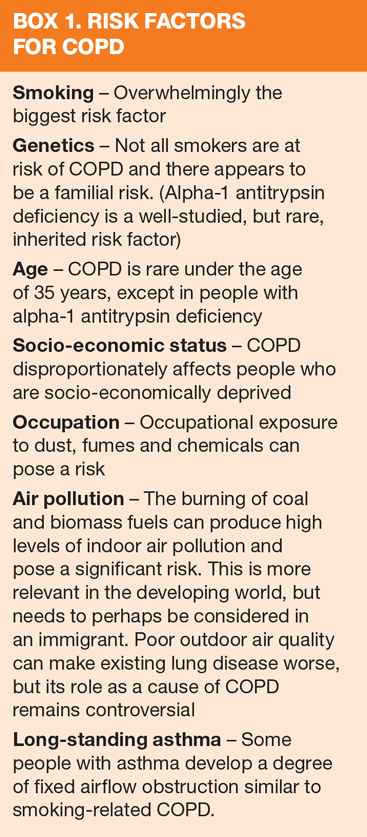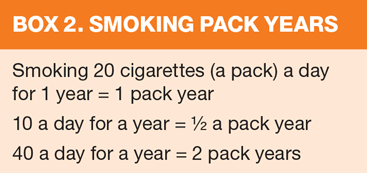
COPD: Prevention, screening and case finding
Rachel Booker
Rachel Booker
Freelance medical writer and editor
Former Clinical Lead for COPD and Spirometry, Education for Health
Primary care nurses are key to the early diagnosis of COPD, when appropriate preventive and management strategies can have the most effect
Chronic obstructive pulmonary disease (COPD) is a largely preventable chronic lung disease characterised by airflow obstruction. The airflow obstruction in COPD is usually progressive and, unlike asthma, is irreversible or only partially reversible and shows little day to day variation.1
COPD kills, it is common and it is costly. In England 23,000 people die of COPD every year — about one every 20 minutes. In the UK as a whole it accounts for 5% of all deaths — almost double the EU average. It is the second most common reason for emergency hospital admission and one of the most costly inpatient conditions. Of people admitted with COPD, 15% die within 3 months of that admission and 25% die within a year.2 The cost to society as a whole is the loss of 24 million working days and £3.8 million of lost productivity.
Someone with COPD may have to give up work early, causing financial hardship. They will become progressively disabled by breathlessness. Eventually COPD will affect every aspect of their life, depriving them of independence and social and familial role, before resulting in their premature death.
It is estimated that there are 3 million people living with COPD in the UK, yet only 900,000 have been identified, accurately diagnosed and appropriately treated. Over 15% of patients are diagnosed only when they present as an emergency hospital admission.2 General practice, as the gatekeeper of the health service, is key to early diagnosis; this is when management interventions can have the most effect and there is the greatest potential to prevent disease progression and improve patient outcomes.
RISK FACTORS
The risk factors for COPD are listed in Box 1. In the UK, and other countries in the developed world, the most important of these is cigarette smoking.3 A history of 20 smoking pack years or more constitutes a significant risk. (Box 2)
In a susceptible smoker — and as many as 25% of smokers may fit this category4 — cigarette smoke causes progressive destruction of lung tissue, resulting in irreversible narrowing and scarring of the airways and loss of the alveolar interface where gas exchange takes place. These changes result in the typical symptoms of COPD:
- Chronic cough and sputum
- Breathlessness on exertion
- Frequent winter chest infections.1
Richie, in our case study, is described as a 'heavy smoker' and has smoked for 22 years. He is most probably at risk, although it would be helpful to calculate his exposure in terms of pack years. He also reports that his father has died prematurely of 'chest trouble' and he may therefore have additional familial risk that increases his susceptibility to the harmful effects of smoking. As a printer he may have been exposed to chemical fumes at work.
PREVENTION
'Prevention is better than cure.' This is as true of COPD as it is of other ailments. In the case of COPD the most effective and important preventive measure is to stop people even starting to smoke. Failing that, it is to persuade smokers to quit as early as possible. Public awareness campaigns, informing people of the dangers of smoking have played an important role and the public is generally well aware of the risks in terms of lung cancer, and possibly cardiovascular disease. Public awareness of COPD, however, remains low. Many people have not heard of COPD, although they may have heard of 'chronic bronchitis' and 'emphysema', and many will be unaware that smoking is the major cause.
All smokers need to be encouraged and supported to stop. Smoking cessation is the first line, most important intervention in COPD. In early disease it may be only treatment needed to prevent crippling, life-limiting, chronic illness. It is also never too late to stop. In more severe COPD, smoking cessation can still produce significant, worthwhile improvements in symptoms and life expectancy.
The availability of smoking cessation support, pharmacological aids to cessation and the ban on smoking in public places has meant that the percentage of the UK population that smokes is falling. Smoking cessation has a major emphasis in QOF and recording smoking status and advising patients will form a major part of your role. It may sometimes feel as if you are 'banging you head against a brick wall' when you remind patients of the dangers of smoking, encourage them to consider stopping and offer support to do so. However, there is good evidence that brief advice from a health professional is effective in helping smokers take the first step towards stopping for good.5
Smokers who, when questioned, express a desire to quit should be encouraged to attend your local smoking cessation service for support. Do you know how to access your local service? Smokers attempting to quit should also be encouraged to use pharmacological aids, such as nicotine replacement therapy. There is ample evidence that both these approaches significantly increase long-term quit rates.6
There is a wealth of material available to raise awareness of the dangers of smoking. COPD specific posters and other materials can be obtained from The British Lung Foundation (www.lunguk.org) as part of their 'Love your Lungs — COPD' campaign.
Richie has already taken the most important step towards preventing COPD. He needs to be congratulated and encouraged to remain a non-smoker.
SCREENING
'Screening is a process of identifying apparently healthy people who may be at increased risk of a disease or condition. They can then be offered information, further tests and appropriate treatment to reduce their risk and/or any complications arising from the disease or condition.'7
A review of the evidence for a screening programme for COPD was conducted by the UK National Screening Committee in 2013.7 It has recommended that a screening programme cannot be justified at this time, because:
- There have been no randomised controlled trials of screening for COPD
- There is limited evidence for the outcomes of treatments and interventions for early stage COPD
- The evidence that spirometry prompts smokers to quit is inconclusive
- The test options for a population-wide screening programme present challenges that remain to be resolved
- There are current prevention activities, including the national COPD and tobacco strategies that are still to be fully implemented.
A recently published, Danish study, however, demonstrated that a high-risk, two stage screening approach can be useful.8 Questionnaires asking about smoking status and symptoms of COPD were sent to 1,703 over 65 year olds registered with general practice in Copenhagen. Smokers and former smokers, and those who reported morning cough with sputum and/or dyspnoea with or without a smoking history, were determined to be 'at risk of COPD' and were invited to undergo spirometry. The response rate to the questionnaire was high — 81.2%. Of those that responded 58.5% were found to be 'at risk of COPD' and 40% of those 'at risk' underwent spirometry. Of those found to have COPD 42.3% had mild, 43.3% moderate and 14.4% severe or very severe disease. A possible advantage of the approach used in this study is its inclusion of individuals with no smoking history but a history of breathlessness and/or chronic productive cough. Screening and case-finding efforts have mainly focussed on current and ex-smokers, but COPD can sometimes occur in non-smokers. It is also noteworthy that over half of the patients in this age group were considered to be 'at risk'.
CASE FINDING
While a national screening programme is not currently recommended in the UK, there is evidence for case-finding of symptomatic individuals. This offers a way forward to finding the more than 2 million undiagnosed individuals estimated to be living with COPD in the UK.
Case-finding is the targeted screening of symptomatic patients at high risk of lung disease and it can produce a high yield. In one study of opportunistic case-finding, 27% of current and ex-smokers over 35 years with a chronic cough were found to have reduced lung function.9
A simple questionnaire, that could be used during a consultation or as a poster in the waiting room, can help identify people likely to have COPD.10 (Box 3)
'Pocket' spirometry can be a helpful case-finding tool to identify those symptomatic individuals who need full spirometric assessment. These battery powered, hand held spirometers are cheap and can measure FEV1 with reasonable accuracy, provided the patient's effort is good. If the FEV1 is greater than 80% of predicted the likelihood of COPD is low. Those with an FEV1 less than 80% of predicted merit further, diagnostic spirometry conducted on appropriate equipment by a trained operator.11 Formal spirometry could also be used for case-finding, but as it is more time-consuming this may be impractical given the time constraints that most practices are under.
You could adopt a case-finding approach with Richie. He could be asked about symptoms of COPD during a travel consultation. If a pocket spirometer is available you could also measure his FEV1. If he reports symptoms and/or his FEV1 is reduced he should be offered full spirometric assessment — perhaps on his return from holiday.
PRACTICALITIES AND PROBLEMS
Opportunistic case-finding of symptomatic smokers is the most practical approach in primary care; 80% of high risk patients are likely to attend the surgery in a 2-year period. However, it requires clinicians to maintain a high index of suspicion for COPD, so that 'opportunistic opportunities' are not missed.
Computer coding can make identification of at-risk candidates for case-finding difficult. For example, a variety of codes could be used when someone attends with a winter chest infection making database searches for the frequent attenders difficult. The recording of smoking status in many practice systems is also problematic. 'Current smoker — 10 a day' and 'Ex-smoker', for example, does not allow you to assess actual cigarette exposure. The ability to record and search for smoking pack years — a far more useful measure — is not widely available.
It is well recognised that COPD patients frequently present late because the onset of the disease is insidious. Cough and sputum could be regarded as a normal consequence of smoking and increasing breathlessness a normal consequence of increasing age. In addition, there is evidence that smokers avoid contact with health professionals because they will be told to stop smoking.12 A case-finding approach relies on the at-risk population both attending and being aware that they are at risk. Posters and awareness campaigns are essential aids to persuading these individuals to attend.
There is no single diagnostic test for COPD. Diagnosis depends on the history and clinical examination. Spirometry is essential to support the diagnosis but does not prove it and it is only useful if it is properly performed and interpreted. Health professionals conducting diagnostic spirometry need to be appropriately trained and spirometry needs to be quality assured.2,11 The arrangements for diagnostic spirometry and quality assurances services should be a priority for every local commissioning group.
CONCLUSION
Recognition of the increasing impact of COPD on the health service and society has pushed COPD, the 'Cinderella' of respiratory disease, up the political and health agenda. To reduce this impact, and improve quality of life and life expectancy for patients, it is essential that people with COPD are identified, accurately diagnosed and appropriately treated as early as possible. We need to find the 'missing millions' of COPD patients and primary care is at the front line of the search.
REFERENCES
1. National Institute for Health and Clinical Excellence. Chronic obstructive pulmonary disease: Management of chronic obstructive pulmonary disease in adults in primary and secondary care. Clinical guideline 101. 2010. http://guidance.nice.org.uk/CG101/NICEGuidance/pdf/English
2. Department of Health. An Outcomes Strategy for COPD and Asthma: NHS Companion Document. 2012. https://www.gov.uk/government/publications/an-outcomes-strategy-for-copd-and-asthma-nhs-companion-document
3. Global Initiative for Chronic Obstructive Lung Disease. Global strategy for the diagnosis, management and prevention of chronic obstructive pulmonary disease. 2014 http://www.goldcopd.org/uploads/users/files/GOLD_Report_2014_Jan23.pdf
4. Løkke A, Lange P, Scharling H et al. Developing COPD: a 25 year follow up study of the general population. Thorax 2006; 61: 935-9
5. Stead LF, Bergson G, Lancaster T. Physician advice for smoking cessation (A review) The Cochrane Library 2008; Issue 4 http://www.thecochranelibrary.com/userfiles/ccoch/file/World%20No%20Tobacco%20Day/CD000165.pdf
6. National Institute for Health and Care Excellence. Smoking cessation services. 2008 (updated 2013) http://www.nice.org.uk/nicemedia/live/11925/39596/39596.pdf
7. UK National Screening Committee. The UK NSC policy on Chronic Obstructive Pulmonary Disease. 2013 http://www.screening.nhs.uk/copd
8. Lyngsø AM, Gottlieb V, Backer V et al. Early detection of COPD in primary care: the Copenhagen COPD screening project. COPD 2013; 10(2): 208-15
9. van Schayck CP. Loozen JM, Wagena E et al. Detecting patients at high risk of developing chronic obstructive pulmonary disease in general practice: cross sectional case-finding study. British Medical Journal 2002; 324: 1370-4
10. Global Initiative for Chronic Obstructive Lung Disease. Could it be COPD? Available from http://www.goldcopd.org/could-it-be-copd.html
11. Levy ML, Quanjer PH, Booker R et al. Diagnostic spirometry in primary care: proposed standards for general practice compliant with American Thoracic Society and European Respiratory Society recommendations. Primary Care Respiratory Journal 2009; 18(3): 130-47 http://www.thepcrj.org/journ/vol18/18_3_130_147.pdf
12. Halpin DMG, Ferenbach C, Bellamy D, Rudolph M on behalf of the BTS COPD Consortium. What does the general public know about COPD? Thorax 2002; 57 (Suppl III): S149, iii4
Related articles
View all Articles


